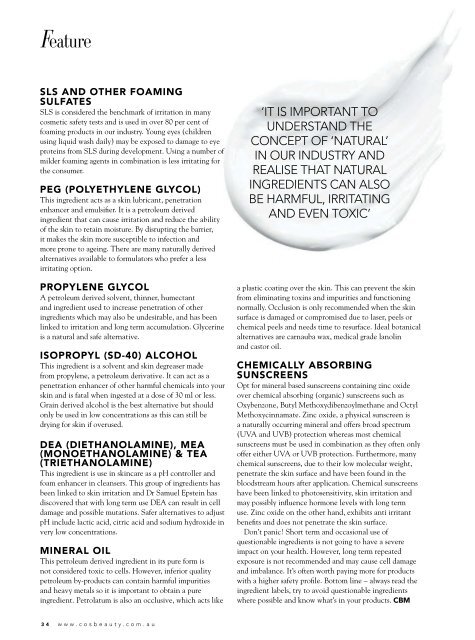CosBeauty Magazine #80
CosBeauty is the #BeautyAddict's guide to lifestyle, health and beauty in Australia. In this issue we look at: • Breast Surgery - augmentation explained • Celebrity Beauty Ranges • Is your phone ageing you? • Bridal Makeup Trends • Under the influence - The Instagram Stars shaping the Beauty Industry • Share the Dignity - Be part of the new movement giving products to this in need.
CosBeauty is the #BeautyAddict's guide to lifestyle, health and beauty in Australia. In this issue we look at:
• Breast Surgery - augmentation explained
• Celebrity Beauty Ranges
• Is your phone ageing you?
• Bridal Makeup Trends
• Under the influence - The Instagram Stars shaping the Beauty Industry
• Share the Dignity - Be part of the new movement giving products to this in need.
Create successful ePaper yourself
Turn your PDF publications into a flip-book with our unique Google optimized e-Paper software.
Feature<br />
SLS and other foaming<br />
sulfates<br />
SLS is considered the benchmark of irritation in many<br />
cosmetic safety tests and is used in over 80 per cent of<br />
foaming products in our industry. Young eyes (children<br />
using liquid wash daily) may be exposed to damage to eye<br />
proteins from SLS during development. Using a number of<br />
milder foaming agents in combination is less irritating for<br />
the consumer.<br />
PEG (Polyethylene glycol)<br />
This ingredient acts as a skin lubricant, penetration<br />
enhancer and emulsifier. It is a petroleum derived<br />
ingredient that can cause irritation and reduce the ability<br />
of the skin to retain moisture. By disrupting the barrier,<br />
it makes the skin more susceptible to infection and<br />
more prone to ageing. There are many naturally derived<br />
alternatives available to formulators who prefer a less<br />
irritating option.<br />
Propylene glycol<br />
A petroleum derived solvent, thinner, humectant<br />
and ingredient used to increase penetration of other<br />
ingredients which may also be undesirable, and has been<br />
linked to irritation and long term accumulation. Glycerine<br />
is a natural and safe alternative.<br />
Isopropyl (SD-40) alcohol<br />
This ingredient is a solvent and skin degreaser made<br />
from propylene, a petroleum derivative. It can act as a<br />
penetration enhancer of other harmful chemicals into your<br />
skin and is fatal when ingested at a dose of 30 ml or less.<br />
Grain derived alcohol is the best alternative but should<br />
only be used in low concentrations as this can still be<br />
drying for skin if overused.<br />
DEA (diethanolamine), MEA<br />
(Monoethanolamine) & TEA<br />
(triethanolamine)<br />
This ingredient is use in skincare as a pH controller and<br />
foam enhancer in cleansers. This group of ingredients has<br />
been linked to skin irritation and Dr Samuel Epstein has<br />
discovered that with long term use DEA can result in cell<br />
damage and possible mutations. Safer alternatives to adjust<br />
pH include lactic acid, citric acid and sodium hydroxide in<br />
very low concentrations.<br />
Mineral Oil<br />
This petroleum derived ingredient in its pure form is<br />
not considered toxic to cells. However, inferior quality<br />
petroleum by-products can contain harmful impurities<br />
and heavy metals so it is important to obtain a pure<br />
ingredient. Petrolatum is also an occlusive, which acts like<br />
‘It is important to<br />
understand the<br />
concept of ‘natural’<br />
in our industry and<br />
realise that natural<br />
ingredients can also<br />
be harmful, irritating<br />
and even toxic’<br />
a plastic coating over the skin. This can prevent the skin<br />
from eliminating toxins and impurities and functioning<br />
normally. Occlusion is only recommended when the skin<br />
surface is damaged or compromised due to laser, peels or<br />
chemical peels and needs time to resurface. Ideal botanical<br />
alternatives are carnauba wax, medical grade lanolin<br />
and castor oil.<br />
Chemically absorbing<br />
sunscreens<br />
Opt for mineral based sunscreens containing zinc oxide<br />
over chemical absorbing (organic) sunscreens such as<br />
Oxybenzone, Butyl Methoxydibenzoylmethane and Octyl<br />
Methoxycinnamate. Zinc oxide, a physical sunscreen is<br />
a naturally occurring mineral and offers broad spectrum<br />
(UVA and UVB) protection whereas most chemical<br />
sunscreens must be used in combination as they often only<br />
offer either UVA or UVB protection. Furthermore, many<br />
chemical sunscreens, due to their low molecular weight,<br />
penetrate the skin surface and have been found in the<br />
bloodstream hours after application. Chemical sunscreens<br />
have been linked to photosensitivity, skin irritation and<br />
may possibly influence hormone levels with long term<br />
use. Zinc oxide on the other hand, exhibits anti irritant<br />
benefits and does not penetrate the skin surface.<br />
Don’t panic! Short term and occasional use of<br />
questionable ingredients is not going to have a severe<br />
impact on your health. However, long term repeated<br />
exposure is not recommended and may cause cell damage<br />
and imbalance. It’s often worth paying more for products<br />
with a higher safety profile. Bottom line – always read the<br />
ingredient labels, try to avoid questionable ingredients<br />
where possible and know what’s in your products. CBM<br />
34 www.cosbeauty.com.au


















